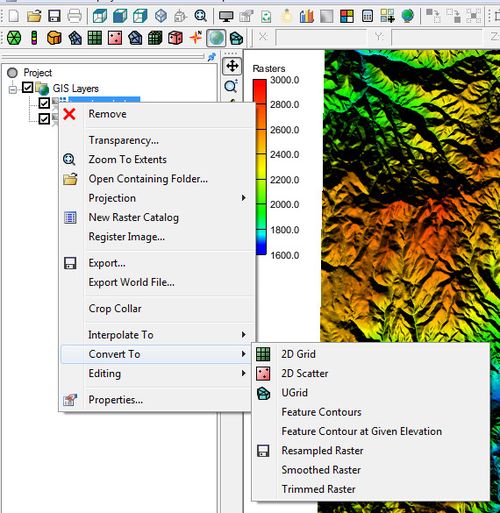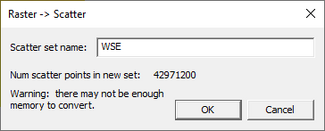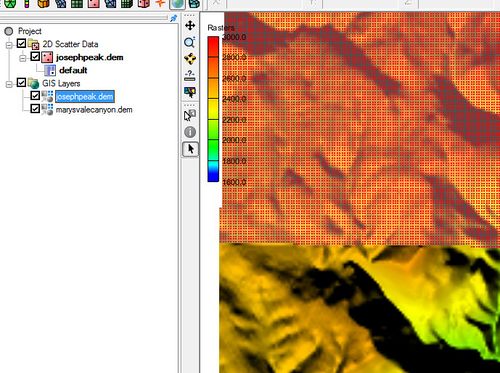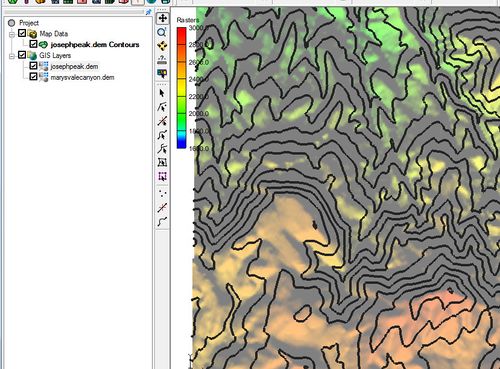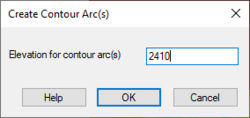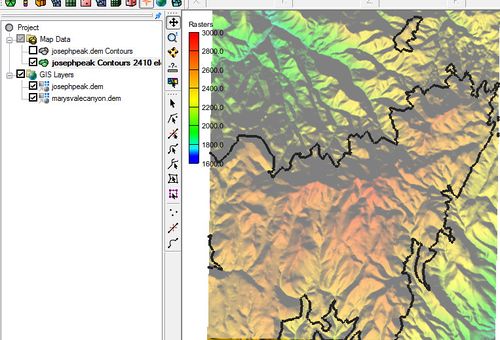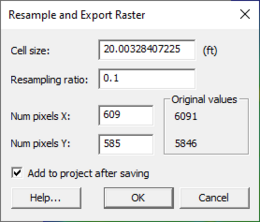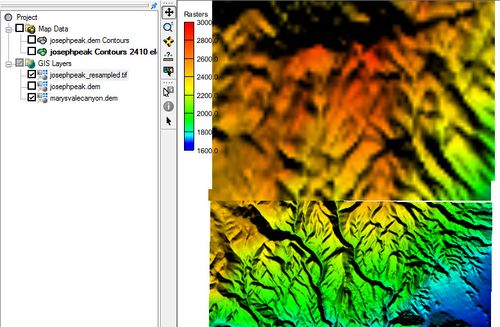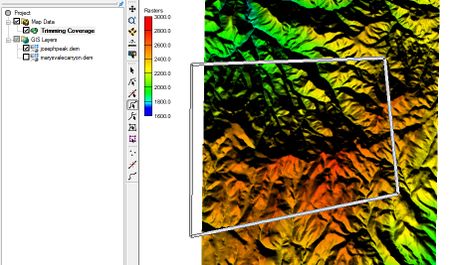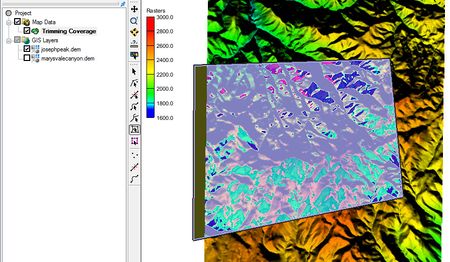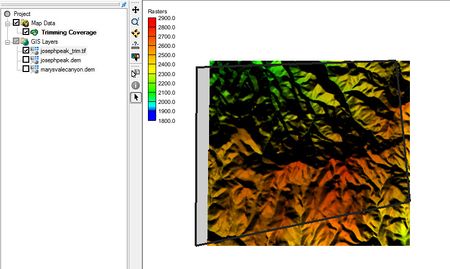GIS Conversion and Editing: Difference between revisions
| (46 intermediate revisions by 3 users not shown) | |||
| Line 1: | Line 1: | ||
[[File:GISrightMenu.jpg|thumb|500 px|Example of a GIS item right-click menu in | [[File:GISrightMenu.jpg|thumb|500 px|Example of a GIS item right-click menu in GMS.]] | ||
GMS, SMS, and WMS can load GIS data such as digital elevation models (DEMs) and images. This GIS data will appear in the GIS Data section of the | GMS, SMS, and WMS can load GIS data such as digital elevation models (DEMs) and images. This GIS data will appear in the GIS Data section of the Project Explorer. | ||
==GIS Data Conversion== | ==GIS Data Conversion== | ||
Both GMS and SMS offer methods to convert GIS data. Right-clicking on a GIS data item in the | Both GMS and SMS offer methods to convert GIS data. Right-clicking on a GIS data item in the Project Explorer brings up a menu with a ''Convert To'' sub-menu. The commands in the ''Convert To'' sub-menu are: | ||
{{Only in print| | {{Only in print| | ||
*'''2D grid''' | *'''2D grid''' | ||
| Line 14: | Line 14: | ||
*'''Merged Raster'''}} | *'''Merged Raster'''}} | ||
===Raster to 2D Scatter=== | ===Raster to 2D Scatter=== | ||
Selecting the command ''Convert To'' | '''2D Scatter''' will bring up the ''Raster → Scatter'' dialog. The dialog shows the number of scatter point that will be generated in the new set and | Selecting the command ''Convert To'' | '''2D Scatter''' will bring up the ''Raster → Scatter'' dialog. The dialog shows the number of scatter point that will be generated in the new set and allows naming the new scatter set. By default, the name of new scatter set will be the same as the raster set unless changed. | ||
[[File:RasterToScatter. | [[File:RasterToScatter.png|thumb|none|325 px|Example of the ''Raster → Scatter'' dialog.]] | ||
By default scatter points are shown in red unless changed in the ''Display Options'' dialog. | By default scatter points are shown in red unless changed in the ''Display Options'' dialog. It may necessary to zoom in to see each point. Scatter points are visible in other views while the DEM is visible only in plan view. | ||
[[File:RasterToScatterExample.jpg|thumb|none|500 px|Example of a scatter set generated from a raster set.]] | [[File:RasterToScatterExample.jpg|thumb|none|500 px|Example of a scatter set generated from a raster set.]] | ||
===Feature Contours=== | ===Feature Contours=== | ||
Activating this command will automatically generate contours which will appear as a new coverage under Map Data in the | Activating this command will automatically generate contours which will appear as a new coverage under Map Data in the Project Explorer. By default, contour lines are shown in black unless the contour color is changed in the ''Display Options'' dialog. The contour interval is found by creating ten contours evenly spaced between the min and max dataset values. | ||
[[File:GIS FeatureContours.jpg|thumb|none|500 px| Generated feature contours appearing as black lines.]] | [[File:GIS FeatureContours.jpg|thumb|none|500 px| Generated feature contours appearing as black lines.]] | ||
===Feature Contours at Given Elevation=== | ===Feature Contours at Given Elevation=== | ||
[[File:GIS CreateContourArc.jpg|thumb|250 px|Example of the ''Create Contour Arc'' dialog.]] | [[File:GIS CreateContourArc.jpg|thumb|250 px|Example of the ''Create Contour Arc'' dialog.]] | ||
This command will bring up the ''Create Contour Arc'' dialog. In this dialog | This command will bring up the ''Create Contour Arc'' dialog. In this dialog, specify an elevation to be used in generating the contours. | ||
After entering an elevation and clicking '''OK''', contours will be generated similar to those created with the '''Feature Contours''' command but using the specified elevation. Only contours at the specified elevation will be generated. | After entering an elevation and clicking '''OK''', contours will be generated similar to those created with the '''Feature Contours''' command but using the specified elevation. Only contours at the specified elevation will be generated. | ||
[[File:FeatureContoursGivenElevation.jpg|thumb|none|500 px|Example of feature contours generated using a given elevation.]] | [[File:FeatureContoursGivenElevation.jpg|thumb|none|500 px|Example of feature contours generated using a given elevation.]] | ||
===Flood Depths=== | |||
This command will create a mapped depth raster. This requires an elevation raster and a water surface elevation dataset. Clicking the command from an elevation raster will bring up a ''Select Geometry and Dataset'' dialog where the geometry containing the water surface elevation dataset can be selected. Once the water surface elevation dataset has been specified, the new raster can be saved. | |||
==GIS Data Editing== | ==GIS Data Editing== | ||
===Resampled Raster=== | ===Resampled Raster=== | ||
[[File:ResampleExportRaster. | <!--Resample%20and%20Export%20Raster--> | ||
[[File:ResampleExportRaster.png|thumb|260 px|''Resample and Export Raster'' dialog.]] | |||
*''Cell size'' – | The '''Export''' command will bring up the ''Resample and Export Raster'' dialog. Resampling creates a new DEM covering the bounds of the selected DEM with a specified spacing. The dialog has the following options: | ||
*''Resampling ratio'' – | *''Cell size'' – Specify the size of each cell based on the ''Resampling ratio''. | ||
*''Num pixels'' X – | *''Resampling ratio'' – Specifies the resampling ratio. This is required for processing. Changing this field will change the other fields in the dialog automatically. | ||
*''Num pixels'' Y – | *''Num pixels'' X – The number of pixels on the x axis that will be generated. The original number will be displayed to the right. | ||
*''Add to project after saving'' – | *''Num pixels'' Y – The number of pixels on the y axis. The original number will be displayed to the right. | ||
*''Add to project after saving'' – Toggling this option on will load the resampled file into GMS/SMS upon completion. | |||
After completing the ''Resample and Export Raster'' dialog and clicking '''OK''' the ''Save As'' dialog will appear | After completing the ''Resample and Export Raster'' dialog, and clicking '''OK''', the ''Save As'' dialog will appear to save a file with the resampled data. XMS uses the [https://gdal.org/programs/gdalwarp.html default GDAL interpolation process] to resample the raster. | ||
[[File:ResampledRasterData.jpg|thumb|none|500 px|Example of resampled raster data.]] | [[File:ResampledRasterData.jpg|thumb|none|500 px|Example of resampled raster data.]] | ||
===Smoothed Raster=== | ===Smoothed Raster=== | ||
[[File:RasterSmoothingOpts.jpg|thumb| | This command will bring up the ''Smooth Raster'' dialog. The dialog is used to smooth the values on the DEM based on use specified weighting functions. The dialog has the following options: | ||
This command will bring up the ''Raster Smoothing Options'' dialog. The dialog has the following options: | *''Input raster DEM file'' – Select a raster in the project, | ||
*''Filter Size'' – | *''Output raster file'' – Enter a name for the smoothed raster generated with the tool. | ||
*''Number of iterations'' – | *''Size of the filter kernal'' – To smooth the raster, an N x N filter matrix is placed over each elevation point and a new elevation is computed by taking an inverse-distance weighted average of all elevations within the filter. The dimension of N can be specified as either ''3x3'' or ''5x5'', meaning that new elevations are computed from either the nearest 8 or 24 neighboring points. | ||
*''Maximum change in elevation'' – | *''Maximum difference in normal vector, in degrees'' | ||
*''Filter ratio'' – | *''Number of interations'' – Specify the number of smoothing iterations. By default only one iteration is done, but sometimes several smoothing iterations are required to propagate a change in elevations across a large flat area. | ||
*''Maximum allowable absolute elevation change'' – Can be used to ensure that the integrity of the original elevations are maintained. | |||
*''Optional multiplier for when the vertical and horizontal units are not the same'' | |||
<!--replaced by Smooth Raster tool in toolbox | |||
[[File:RasterSmoothingOpts.jpg|thumb|250 px|''Raster Smoothing Options'' dialog.]] | |||
This command will bring up the ''Raster Smoothing Options'' dialog. The dialog is used to smooth the values on the DEM based on use specified weighting functions. The dialog has the following options: | |||
*''Filter Size'' – To smooth the raster, an N x N filter matrix is placed over each elevation point and a new elevation is computed by taking an inverse-distance weighted average of all elevations within the filter. The dimension of N can be specified as either ''3x3'' or ''5x5'', meaning that new elevations are computed from either the nearest 8 or 24 neighboring points. | |||
*''Number of iterations'' – Specify the number of smoothing iterations. By default only one iteration is done, but sometimes several smoothing iterations are required to propagate a change in elevations across a large flat area. | |||
*''Maximum change in elevation'' – Can be used to ensure that the integrity of the original elevations are maintained. | |||
*''Filter ratio'' – Should be between 0-1, and is used to specify the weight of the central cell of the filtering matrix. | |||
After completing | After completing the ''Raster Smoothing Options'' dialog, and clicking '''OK''', the ''Save As'' dialog will appear to save a file with the smoothed data. | ||
--> | |||
===Trimmed Raster=== | ===Trimmed Raster=== | ||
Coverage polygons must be selected to define the trimming rectangle. If this is not done, then a warning dialog will appear as a reminder. | This command creates a new DEM from the selected DEM trimmed to the bounds of the active coverage or the selected polygons of the active coverage. Coverage polygons must be selected to define the trimming rectangle. If this is not done, then a warning dialog will appear as a reminder. | ||
To create a trimmed raster: | To create a trimmed raster: | ||
#Select a coverage (or create a new coverage) in the Map module. | #Select a coverage (or create a new coverage) in the Map module. | ||
#Select the '''Create Arc''' tool and draw a closed set of arcs. | #Select the '''Create Feature Arc''' tool and draw a closed set of arcs. | ||
#:[[File:TrimmedRaster1.jpg|thumb|none|450 px|Closed set of arcs drawn over a raster.]] | #:[[File:TrimmedRaster1.jpg|thumb|none|450 px|Closed set of arcs drawn over a raster.]] | ||
#While the arcs are selected, go to ''Feature Objects'' |'''Build Polygons'''. | #While the arcs are selected, go to ''Feature Objects'' | '''Build Polygons'''. | ||
#Use the '''Select Polygon''' tool to select the polygon just created. | #Use the '''Select Polygon''' tool to select the polygon just created. | ||
#:[[File:TrimmedRaster2.jpg|thumb|none|450 px|Selected polygon just prior to using the '''Trimmed Raster''' command.]] | #:[[File:TrimmedRaster2.jpg|thumb|none|450 px|Selected polygon just prior to using the '''Trimmed Raster''' command.]] | ||
#Right-click a DEM in the GIS data and select ''Convert To'' | '''Trimmed Raster'''. | #Right-click a DEM in the GIS data and select ''Convert To'' | '''Trimmed Raster'''. | ||
#The ''Save As'' dialog will appear | #The ''Save As'' dialog will appear to save a file with the trimmed data. | ||
#:[[File:TrimmedRaster3.jpg|thumb|none|450 px|Example of a trimmed raster.]] | #:[[File:TrimmedRaster3.jpg|thumb|none|450 px|Example of a trimmed raster.]] | ||
The final raster is trimmed along the rectangle enclosing the polygon. Trimmed rasters will also trim to the rectangle enclosing multiple selected polygons. | The final raster is trimmed along the rectangle enclosing the polygon. Trimmed rasters will also trim to the rectangle enclosing multiple selected polygons. | ||
=== Merged Raster=== | === Merged Raster=== | ||
Two or more DEM datasets can be merged together by doing the following: | This command appears when multiple rasters are selected. It creates a new raster that covers all selected rasters with a resolution set to the smallest cell size of any of the selected rasters. Two or more DEM datasets can be merged together by doing the following: | ||
#Select two or more DEM items in the | #Select two or more DEM items in the Project Explorer by holding down the ''Shift'' key while selecting each item. | ||
#Right-click on one of the selected DEMs and select ''Convert To'' | '''Merged Raster''. This command is only available when multiple raster items have been selected. | #Right-click on one of the selected DEMs and select ''Convert To'' | '''Merged Raster'''. This command is only available when multiple raster items have been selected. | ||
#The ''Save As'' dialog will appear to save a file with the merged data. | #The ''Save As'' dialog will appear to save a file with the merged data. | ||
The new merged DEM will be visible in the | The new merged DEM will be visible in the Project Explorer. When merging, the smallest cell size among the merging rasters is used. | ||
=== Edit Raster === | === Edit Raster === | ||
A DEM may have bad cell values or based on the resolution may not represent continuous values along a line. These | A DEM may have bad cell values or based on the resolution may not represent continuous values along a line. These values can be edited to remove the bad value or ensure continuous representation of a feature such as an embankment or channel. The new values are specified using feature objects (arcs or nodes) in the Map module. To create an edited raster: | ||
#Select (or create) one or more feature arcs/feature nodes with the desired raster values specified on the feature object. (i.e. the z-value specified for the nodes/vertices/points represent the values desired under the feature objects in the raster) | #Select (or create) one or more feature arcs/feature nodes with the desired raster values specified on the feature object. (i.e. the z-value specified for the nodes/vertices/points represent the values desired under the feature objects in the raster) | ||
#Right-click on one of the selected DEMs and select ''Editing'' | ''Arc Elevation Profile''. | #Right-click on one of the selected DEMs and select ''Editing'' | '''Arc Elevation Profile'''. | ||
#The ''Save As'' dialog will appear to save a file with the edited data. | #The ''Save As'' dialog will appear to save a file with the edited data. | ||
The new edited DEM will be visible in the | The new edited DEM will be visible in the Project Explorer. | ||
==Saving Raster Data== | ==Saving Raster Data== | ||
Raster data being converted can be saved in | Raster data being converted can be saved in the following formats: | ||
*GeoTiff Files (*.tif) | |||
*Arc Info ASCII Grid Files (*.asc) | |||
<!-- | |||
{| | {| | ||
|- | |- | ||
| Line 110: | Line 128: | ||
*Windsim GWS Files (*.gws) | *Windsim GWS Files (*.gws) | ||
|} | |} | ||
--> | |||
==Related Topics== | ==Related Topics== | ||
| Line 116: | Line 135: | ||
|width="200"| | |width="200"| | ||
*[[Raster Options]] | *[[Raster Options]] | ||
*[[Get Online Maps]] | |||
*[[WMS:Smoothing_DEMs|Smoothing DEMs]] | *[[WMS:Smoothing_DEMs|Smoothing DEMs]] | ||
| | |valign="top"| | ||
*[[GMS:GIS Module|GMS GIS Module]] | *[[GMS:GIS Module|GMS GIS Module]] | ||
*[[SMS:GIS Module|SMS GIS Module]] | *[[SMS:GIS Module|SMS GIS Module]] | ||
| Line 126: | Line 146: | ||
{{Navbox SMS}} | {{Navbox SMS}} | ||
[[Category:GIS]] | [[Category:GIS|Conv]] | ||
[[Category:Raster]] | [[Category:Raster]] | ||
[[Category:SMS Dialogs]] | [[Category:SMS Raster Dialogs]] | ||
[[Category:GMS Dialogs]] | [[Category:SMS GIS Dialogs|Conv]] | ||
[[Category:SMS GIS]] | [[Category:GMS GIS Dialogs|Conv]] | ||
[[Category:SMS GIS|Conv]] | |||
[[Category:Exporting Data|conv]] | |||
[[Category:External Links]] | |||
Latest revision as of 18:41, 28 September 2023
GMS, SMS, and WMS can load GIS data such as digital elevation models (DEMs) and images. This GIS data will appear in the GIS Data section of the Project Explorer.
GIS Data Conversion
Both GMS and SMS offer methods to convert GIS data. Right-clicking on a GIS data item in the Project Explorer brings up a menu with a Convert To sub-menu. The commands in the Convert To sub-menu are:
Raster to 2D Scatter
Selecting the command Convert To | 2D Scatter will bring up the Raster → Scatter dialog. The dialog shows the number of scatter point that will be generated in the new set and allows naming the new scatter set. By default, the name of new scatter set will be the same as the raster set unless changed.
By default scatter points are shown in red unless changed in the Display Options dialog. It may necessary to zoom in to see each point. Scatter points are visible in other views while the DEM is visible only in plan view.
Feature Contours
Activating this command will automatically generate contours which will appear as a new coverage under Map Data in the Project Explorer. By default, contour lines are shown in black unless the contour color is changed in the Display Options dialog. The contour interval is found by creating ten contours evenly spaced between the min and max dataset values.
Feature Contours at Given Elevation
This command will bring up the Create Contour Arc dialog. In this dialog, specify an elevation to be used in generating the contours.
After entering an elevation and clicking OK, contours will be generated similar to those created with the Feature Contours command but using the specified elevation. Only contours at the specified elevation will be generated.
Flood Depths
This command will create a mapped depth raster. This requires an elevation raster and a water surface elevation dataset. Clicking the command from an elevation raster will bring up a Select Geometry and Dataset dialog where the geometry containing the water surface elevation dataset can be selected. Once the water surface elevation dataset has been specified, the new raster can be saved.
GIS Data Editing
Resampled Raster
The Export command will bring up the Resample and Export Raster dialog. Resampling creates a new DEM covering the bounds of the selected DEM with a specified spacing. The dialog has the following options:
- Cell size – Specify the size of each cell based on the Resampling ratio.
- Resampling ratio – Specifies the resampling ratio. This is required for processing. Changing this field will change the other fields in the dialog automatically.
- Num pixels X – The number of pixels on the x axis that will be generated. The original number will be displayed to the right.
- Num pixels Y – The number of pixels on the y axis. The original number will be displayed to the right.
- Add to project after saving – Toggling this option on will load the resampled file into GMS/SMS upon completion.
After completing the Resample and Export Raster dialog, and clicking OK, the Save As dialog will appear to save a file with the resampled data. XMS uses the default GDAL interpolation process to resample the raster.
Smoothed Raster
This command will bring up the Smooth Raster dialog. The dialog is used to smooth the values on the DEM based on use specified weighting functions. The dialog has the following options:
- Input raster DEM file – Select a raster in the project,
- Output raster file – Enter a name for the smoothed raster generated with the tool.
- Size of the filter kernal – To smooth the raster, an N x N filter matrix is placed over each elevation point and a new elevation is computed by taking an inverse-distance weighted average of all elevations within the filter. The dimension of N can be specified as either 3x3 or 5x5, meaning that new elevations are computed from either the nearest 8 or 24 neighboring points.
- Maximum difference in normal vector, in degrees
- Number of interations – Specify the number of smoothing iterations. By default only one iteration is done, but sometimes several smoothing iterations are required to propagate a change in elevations across a large flat area.
- Maximum allowable absolute elevation change – Can be used to ensure that the integrity of the original elevations are maintained.
- Optional multiplier for when the vertical and horizontal units are not the same
Trimmed Raster
This command creates a new DEM from the selected DEM trimmed to the bounds of the active coverage or the selected polygons of the active coverage. Coverage polygons must be selected to define the trimming rectangle. If this is not done, then a warning dialog will appear as a reminder.
To create a trimmed raster:
- Select a coverage (or create a new coverage) in the Map module.
- Select the Create Feature Arc tool and draw a closed set of arcs.
- While the arcs are selected, go to Feature Objects | Build Polygons.
- Use the Select Polygon tool to select the polygon just created.
- Right-click a DEM in the GIS data and select Convert To | Trimmed Raster.
- The Save As dialog will appear to save a file with the trimmed data.
The final raster is trimmed along the rectangle enclosing the polygon. Trimmed rasters will also trim to the rectangle enclosing multiple selected polygons.
Merged Raster
This command appears when multiple rasters are selected. It creates a new raster that covers all selected rasters with a resolution set to the smallest cell size of any of the selected rasters. Two or more DEM datasets can be merged together by doing the following:
- Select two or more DEM items in the Project Explorer by holding down the Shift key while selecting each item.
- Right-click on one of the selected DEMs and select Convert To | Merged Raster. This command is only available when multiple raster items have been selected.
- The Save As dialog will appear to save a file with the merged data.
The new merged DEM will be visible in the Project Explorer. When merging, the smallest cell size among the merging rasters is used.
Edit Raster
A DEM may have bad cell values or based on the resolution may not represent continuous values along a line. These values can be edited to remove the bad value or ensure continuous representation of a feature such as an embankment or channel. The new values are specified using feature objects (arcs or nodes) in the Map module. To create an edited raster:
- Select (or create) one or more feature arcs/feature nodes with the desired raster values specified on the feature object. (i.e. the z-value specified for the nodes/vertices/points represent the values desired under the feature objects in the raster)
- Right-click on one of the selected DEMs and select Editing | Arc Elevation Profile.
- The Save As dialog will appear to save a file with the edited data.
The new edited DEM will be visible in the Project Explorer.
Saving Raster Data
Raster data being converted can be saved in the following formats:
- GeoTiff Files (*.tif)
- Arc Info ASCII Grid Files (*.asc)
Related Topics
GMS – Groundwater Modeling System | ||
|---|---|---|
| Modules: | 2D Grid • 2D Mesh • 2D Scatter Point • 3D Grid • 3D Mesh • 3D Scatter Point • Boreholes • GIS • Map • Solid • TINs • UGrids | |
| Models: | FEFLOW • FEMWATER • HydroGeoSphere • MODAEM • MODFLOW • MODPATH • mod-PATH3DU • MT3DMS • MT3D-USGS • PEST • PHT3D • RT3D • SEAM3D • SEAWAT • SEEP2D • T-PROGS • ZONEBUDGET | |
| Aquaveo | ||
SMS – Surface-water Modeling System | ||
|---|---|---|
| Modules: | 1D Grid • Cartesian Grid • Curvilinear Grid • GIS • Map • Mesh • Particle • Quadtree • Raster • Scatter • UGrid |  |
| General Models: | 3D Structure • FVCOM • Generic • PTM | |
| Coastal Models: | ADCIRC • BOUSS-2D • CGWAVE • CMS-Flow • CMS-Wave • GenCade • STWAVE • WAM | |
| Riverine/Estuarine Models: | AdH • HEC-RAS • HYDRO AS-2D • RMA2 • RMA4 • SRH-2D • TUFLOW • TUFLOW FV | |
| Aquaveo • SMS Tutorials • SMS Workflows | ||
